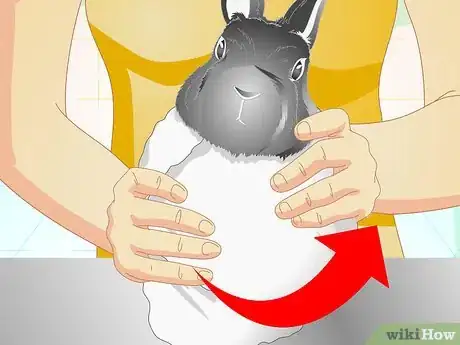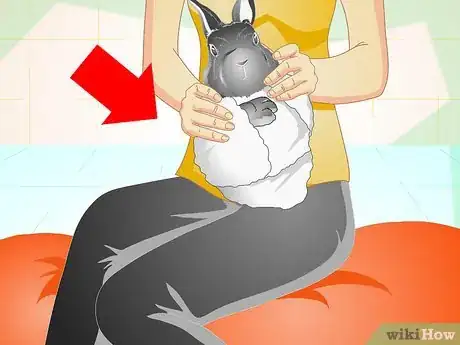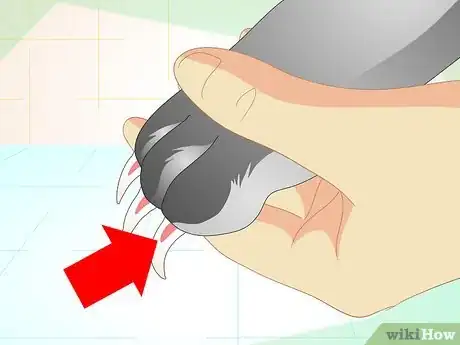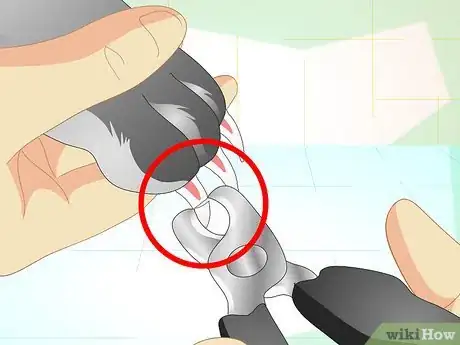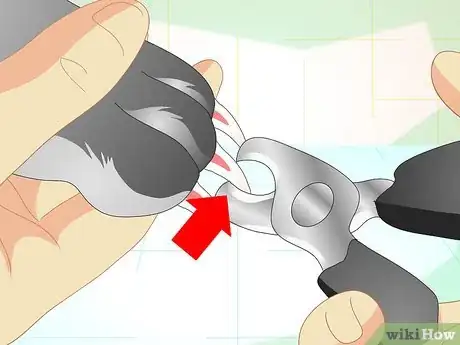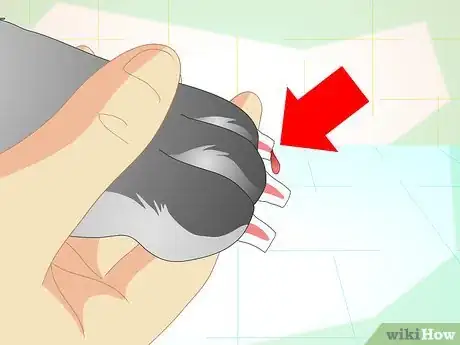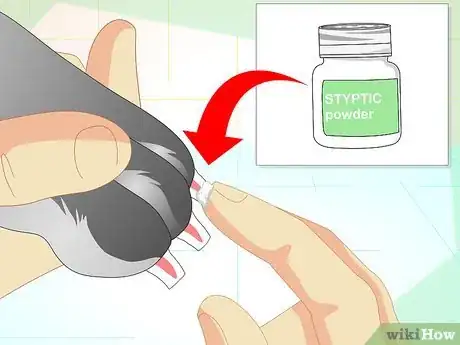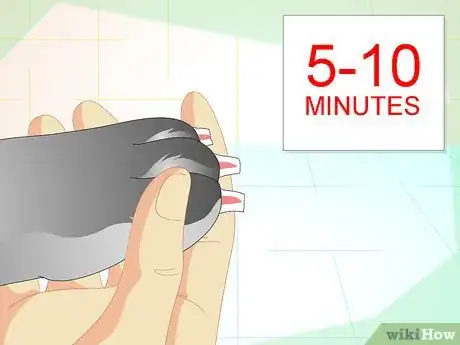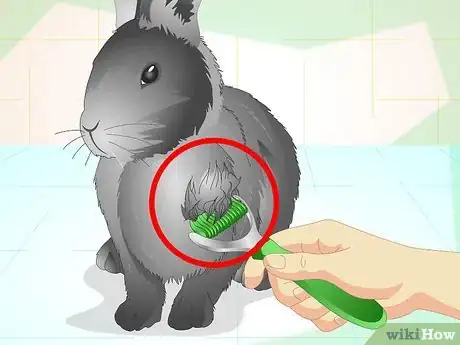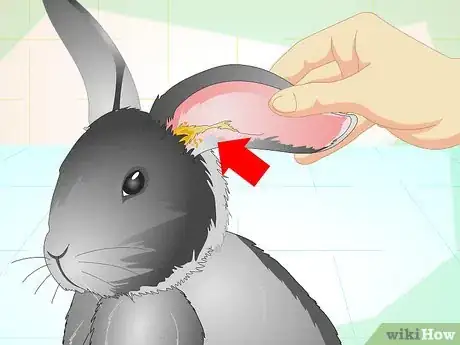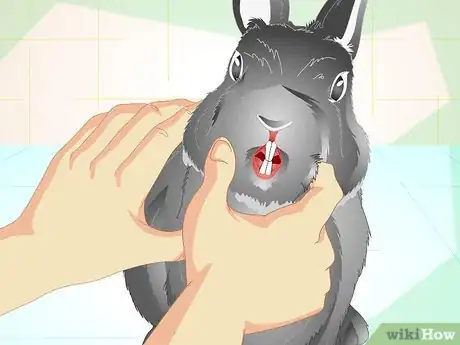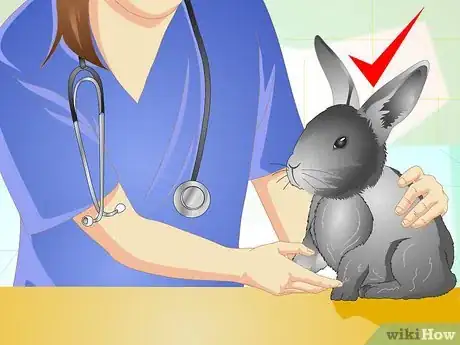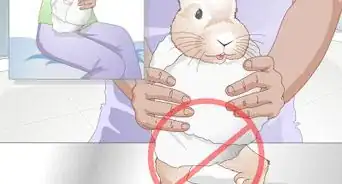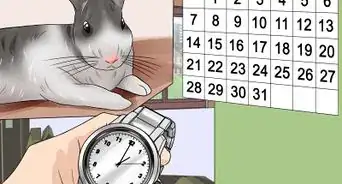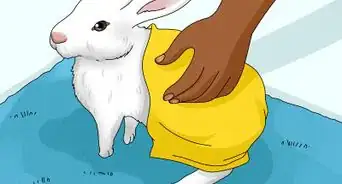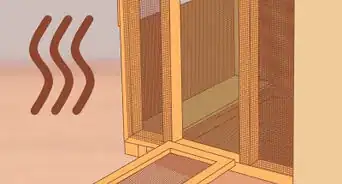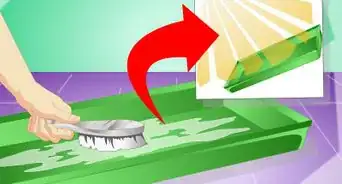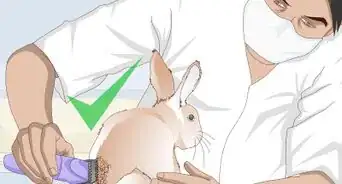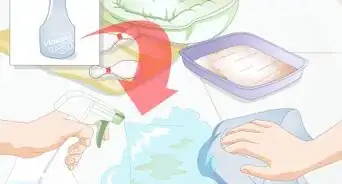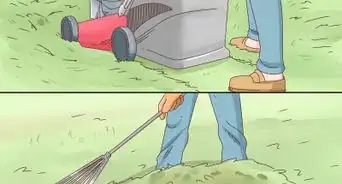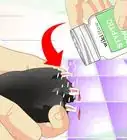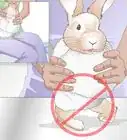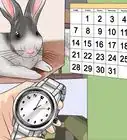This article was co-authored by Pippa Elliott, MRCVS. Dr. Elliott, BVMS, MRCVS is a veterinarian with over 30 years of experience in veterinary surgery and companion animal practice. She graduated from the University of Glasgow in 1987 with a degree in veterinary medicine and surgery. She has worked at the same animal clinic in her hometown for over 20 years.
This article has been viewed 35,950 times.
A rabbit's nails grow continually, and if left untreated they can become unmanageable and cause pain or infections for your pet.[1] You'll need to trim your furry friend's nails every month or so to help him stay healthy and happy. Trimming your rabbit's nails may sound intimidating, but with the right tools and information, it will quickly become a care-free part of your rabbit's grooming process.
Steps
Trimming Your Rabbit's Nails
-
1Gather your materials. Before you begin trimming your rabbit's nails, you'll want to make sure you've got everything you need. Failing to plan ahead can leave you with a squirming, uncooperative rabbit and a lot of scratches. Make sure you have:
- a long-sleeved shirt and long pants for yourself (to prevent scratches)
- a towel to wrap the bunny in
- a flashlight (optional) to find the quick
- nail clippers - some people prefer to use human nail clippers for rabbits, while others prefer a special rabbit nail clipper
- styptic powder, styptic pads, Kwik-Stop, or Cut-Stop to stop the bleeding if you cut too close[2]
-
2Have a friend hold your rabbit. It will be incredibly difficult to attempt to trim your rabbit's nails alone. You probably won't be able to hold the rabbit's body, find the quick, and trim the nails on your own without dropping or injuring the rabbit, so it's best to have someone assist you.[3]
- Wrap the rabbit in a clean towel with his paws sticking out. Make sure your rabbit's head is not covered by the towel, as this may frighten him and/or affect his ability to breathe.
- Make sure your friend is sitting down while holding the rabbit. If the rabbit squirms out of your friend's hands and falls while she's standing, the rabbit may become injured.
Advertisement -
3Get the rabbit into position. Once your friend is holding the wrapped up rabbit, you'll need your friend to get him into position. It's best to have your friend cradle him while also restraining him to protect your rabbit from squirming and/or falling.
- Ensure that the rabbit is held in place in your friend's lap. Lay the rabbit belly-up and upside down, with his head pointed toward your friend's knees.
- Laying a rabbit upside down with his head lower than the rest of his body puts him into a calmer, "trance-like" state. However, some behaviorists advise against putting rabbits in the 'trance' state as they only do this when they are extremely frightened -- the fact that they stay still when belly up is a desperate attempt to make a predator overlook them.
- Have your friend use one hand to support the rabbit around his chest. This will help reduce the chances of him squirming free while you work.
-
4Find the quick. The quick is the term for the vein that runs through your rabbit's nails. The nail grows around and below the quick, so it's important to only trim the excess nail that has grown past the quick without damaging the nerves there.
- You'll need to find the quick on each nail before cutting. Take extra care not to rush this part, as cutting into the quick can be very painful for your rabbit and will cause him to bleed.
- Use a flashlight to find where the vein/quick extends to in each nail. This may be particularly useful if your rabbit has darker nails, which can make it difficult to find the quick with the naked eye.
-
5Cut the nail. Make sure you've identified the quick before cutting into the nail. Once you're ready, proceed with caution and make sure the rabbit is restrained.
- Position the nail clippers in place just below the vein.
- Make sure you cut approximately two millimeters away from the quick.
- Clip firmly to ensure that the nail is cut all the way through. Otherwise, if you only cut halfway through, your rabbit may become frightened and start to thrash and squirm.
-
6Repeat the process. Once you've successfully trimmed one nail, you'll get a pretty good sense of how the rest of the nails go. Some rabbits who have grown up getting regular nail trimmings will get used to it and won't fight as much. Other rabbits may be frightened, and will need extra restraint and reassurance.
- Make sure you get each of the nails on all four paws.
- Give your rabbit a treat when you're finished. He may come to associate the discomfort of nail trimmings with a treat, which could make him calmer in the future.
- Trim your rabbit's nails every four to six weeks to prevent injuries and overgrown nails.[4]
- If you don't feel capable of trimming your rabbit's nails on your own, you can take him to a groomer or a veterinarian for instructions on how to trim the nails. You can also pay to have a groomer (or your vet) trim the nails for you.
Treating an Injured Quick
-
1Identify the bleeding nail. Sometimes no matter how careful you are, you might accidentally cut into the quick. If your rabbit is squirming and struggling, it may be difficult to tell which nail is bleeding, but it's important to determine where to apply pressure and any styptic products (if necessary).
- Try to restrain the rabbit.
- You should be able to tell which paw is bleeding, so while your friend restrains the rabbit's body you'll need to hold that paw and examine it.
-
2Apply pressure. Once you've determined which nail is bleeding, you'll need to put pressure on it. Just like a cut on a human, putting pressure will reduce the flow of blood to the site of the injury, which will help it clot and heal faster.
- Use clean gauze, a clean paper towel, or both.
- Put pressure directly on the wound - in this case, the tip of the nail.
- Applying pressure may be enough to stop the bleeding for a small wound. If it keeps bleeding, you'll need to use a styptic product.
-
3Use a styptic product. Styptic products stop the bleeding when you've accidentally drawn blood. If the quick was cut and won't stop bleeding from pressure alone, you'll need to apply a styptic product to the injured nail.
- If you're using a styptic powder, wipe away the blood and press a pinch of the powder directly into the tip of the bleeding nail.
- If you don't have a styptic powder on hand, you can improvise by using cornstarch or flour in the same way you would apply a styptic product.
- Some people find that gently pressing an injured nail into a bar of mild bath soap can help stop the bleeding.
-
4Make sure it's stopped bleeding. Before you set your rabbit loose in the house or return him to his cage, it's important that you make sure the bleeding has stopped first. Leaving your rabbit unattended or placing him in his cage (which could cause his nail to get stuck in the grate and further injure it) can cause continued bleeding and additional injuries.
- Wait for about 5 to 10 minutes to ensure the bleeding has stopped before leaving your rabbit unattended or returning him to his cage.
Finding Other Ways to Groom Your Rabbit
-
1Brush your rabbit's coat. Rabbits shed their coat every three months. Rabbits will try to lick their coats clean like a cat, but unlike cats they cannot vomit up hairballs. If you don't brush your rabbit regularly he may develop a hairball blockage in his stomach, which could cause him to starve to death.[5]
- Brush your rabbit at least once every week.
- Choose a bristle or pin brush to avoid injuring your rabbit's skin.
- Brush in the natural direction of hair growth - typically, this will be from head to tail.
-
2Detangle mats. Even if you groom your rabbit regularly, he may develop mats from time to time. Mats are tangled clusters of hair that begin growing together. This can cause irritations and infections on the skin below the mat. However, rabbits have exceptionally sensitive skin, and cutting a mat out with scissors could cause serious injuries to the rabbit.[6]
- Check your rabbit for mats every time you brush him.
- If you find a mat, do not cut it out with scissors.
- Use a mat splitter or mat rake to tease out mats and detangle them without cutting.
-
3Check the ears for infection. While you're grooming your rabbit, it may be a good idea to check his ears for signs of infection. Ear infections are quite common among rabbits, so check on his ears periodically to ensure that your rabbit is in good health. If you observe any signs of an ear infection, it's important to take your rabbit to the vet as soon as possible. Common signs of an ear infection include[7] :
- pain/sensitivity to touch
- frequent head shaking
- redness/swelling, especially in the external ear canal
- thick, white fluid in the ear canal (which may sometimes be creamy in texture)
- excessive ear wax
- odor in and around the ear
- crusts forming around the ear canal
- digging at the floor and/or holding down the ear (a sign of pain)
- lack of appetite or interest in food
- patchy hair or loss of hair around the ears
- scaled skin around the ear canal
-
4Examine the teeth. A rabbit's teeth will continue to grow, just like his nails. Usually access to chew toys will help manage the growth of teeth, but occasionally an injury occurs that makes it difficult for your rabbit to chew his wooden toys or eat his food. Check his teeth periodically to make sure they're in good health.
- You'll probably only be able to see the front teeth (incisors) in your rabbit's mouth.
- The incisors should be even. That means both top teeth should be the same length, and so should both bottom teeth.
- Make sure there are no cracks in the teeth, no loose teeth, and no food or debris trapped between the teeth.
- If you observe any problems, contact your vet immediately, as your rabbit may need medical help.
-
5Schedule regular veterinary visits. The best way to prevent health problems is to be proactive in your veterinary visits. No matter what type of pet you have, it's important to ensure that he gets regular checkups and is able to get treatment for any ailments that arise.
- Rabbits should visit the vet at least once every year.
- Older rabbits (over five years old) may need to see the vet twice a year.[8]
- Let your vet know about any problems you've observed or concerns you have about your rabbit's health.
Warnings
- Do not try to trim your rabbit's nails alone unless you have a lot of experience. Otherwise, it's best to have a friend assist you.⧼thumbs_response⧽
- Don't let your rabbit jerk away while you're clipping- this is VERY dangerous!⧼thumbs_response⧽
References
- ↑ http://www.indianahrs.org/ihrs/rabbit-care/nails-teeth.aspx
- ↑ http://www.peteducation.com/article.cfm?c=18+1803&aid=3580
- ↑ http://www.peteducation.com/article.cfm?c=18+1803&aid=3580
- ↑ http://www.indianahrs.org/ihrs/rabbit-care/nails-teeth.aspx
- ↑ http://rabbit.org/faq-grooming/
- ↑ http://rabbit.org/faq-grooming/
- ↑ http://www.petmd.com/rabbit/conditions/ears/c_rb_otitis_externa_media
- ↑ http://rabbit.org/your-house-rabbit%E2%80%99s-first-visit-to-the-veterinarian/

